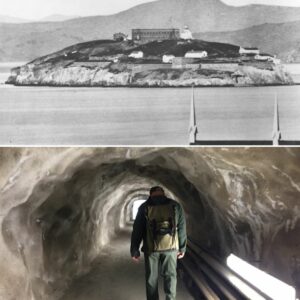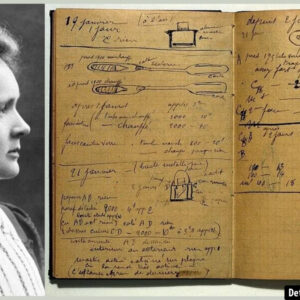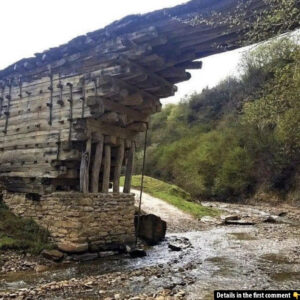The Golden Gate Bridge, now an iconic symbol of San Francisco, had a grand and unforgettable debut in 1937. But the bridge’s opening wasn’t just a typical ribbon-cutting ceremony—it was a celebration that spiraled into an all-out spectacle. From pedestrian parades to chaotic traffic jams, the event quickly became an epic display of both triumph and hilarity. With fireworks, eccentric floats, and an overwhelming sense of excitement, the Golden Gate Bridge’s opening captured the essence of 1930s San Francisco—bold, unpredictable, and full of life.
Pedestrian Day – A Walk Through History
On May 27, 1937, the Golden Gate Bridge opened its gates for Pedestrian Day, welcoming 200,000 people to walk across the 1.7-mile span. It was the first time the public was able to step foot on the bridge, and the excitement was palpable. The event, which was meant to give locals a chance to enjoy the bridge before it officially opened to cars, quickly turned into a spectacle of strange and unique characters. People braved high winds, overhanging fog, the noise from 500 planes in the sky, and warships sailing below them just to be a part of this historic moment.
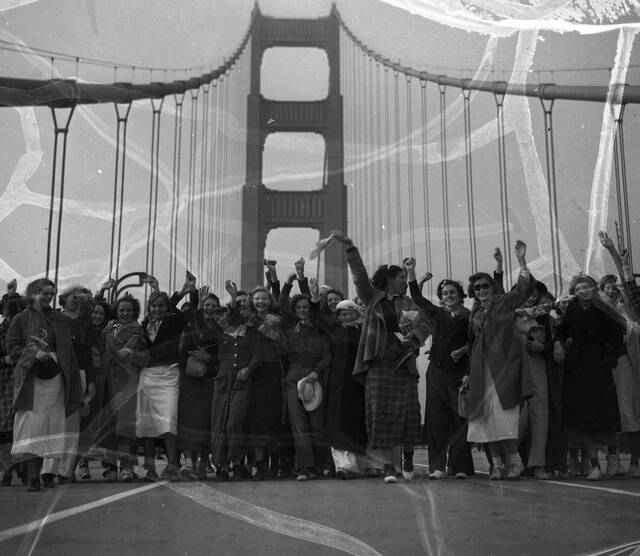
Among the first to cross were a variety of individuals, each adding their own flavor to the event. A 35-year-old man named Milton Pilhasky made his way across the bridge by rolling a pillbox with his nose. Glorention Calegari, a local, crossed on stilts, and two sisters, Minnie and Carmen Perez, became the first to cross on roller skates. Other memorable moments included a Siamese cat on a leash making its way across, and Mildred Farquhar and Kathleen Evulich, two young women who had camped under the bridge the night before to be among the first to cross when the bridge opened at 6 AM.
To immerse yourself in the spirit of Pedestrian Day, watch this video capturing the historic moment when thousands of people first crossed the Golden Gate Bridge, marking a milestone in San Francisco’s history
Clown Car Day: Surreal Ceremonies Before the Cars Roll
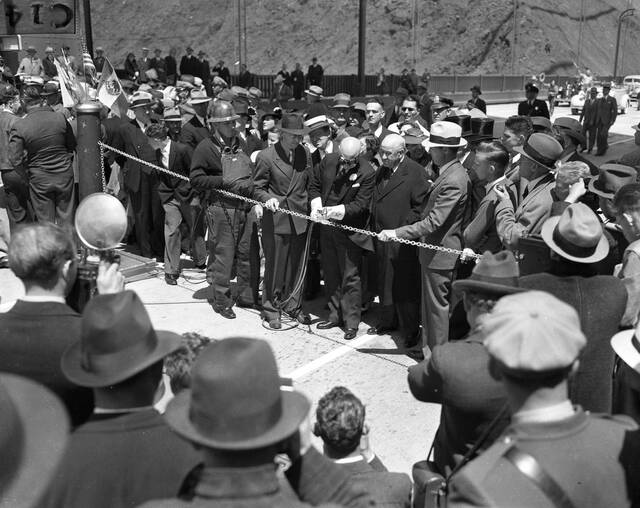
The festivities took a turn into the bizarre on May 28, when “Clown Car Day” was celebrated. Before any cars could cross, the day was filled with peculiar events, including a logging competition and ceremonial torch cutting. Seven men, including the mayor, used blowtorches to sever gold, silver, and copper chains that were ceremoniously draped over the bridge. This ritual, a quirky addition to the day, lasted far longer than expected, adding an unexpected delay before the first vehicles could pass.
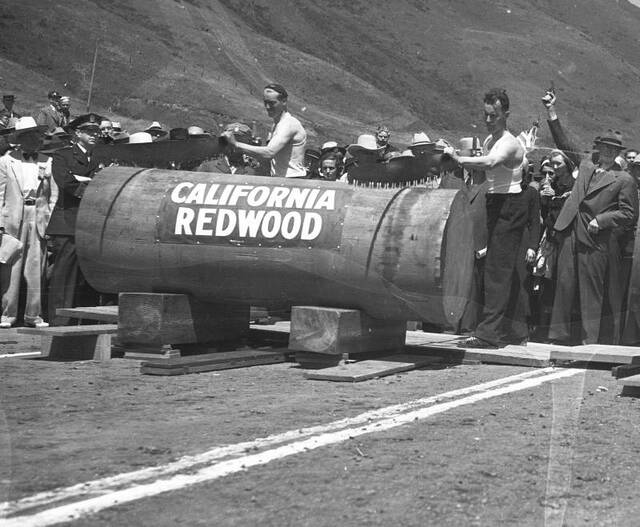
The bridge’s opening wasn’t just about official ceremonies – there was also a competition that made no sense, at least in terms of its relevance to a bridge opening. A logging competition took place, where competitors raced to saw through a 36-inch diameter redwood tree. The winner, Paul Serles from Washington, completed the task in just under three minutes.
Then came the fashion. A “dazzling galaxy of California girls,” as described by the local press, stood across the bridge, draped in shimmering gowns, while Queen Vivian Sorenson stood as the centerpiece of the event. This odd pageantry led to the first cars crossing the bridge, starting with Mrs. Ethyl Olsen and her large family, who piled into her car for the symbolic first ride. However, this quirky event didn’t quite end there.
The Fiesta: A Week-Long Celebration of Madness
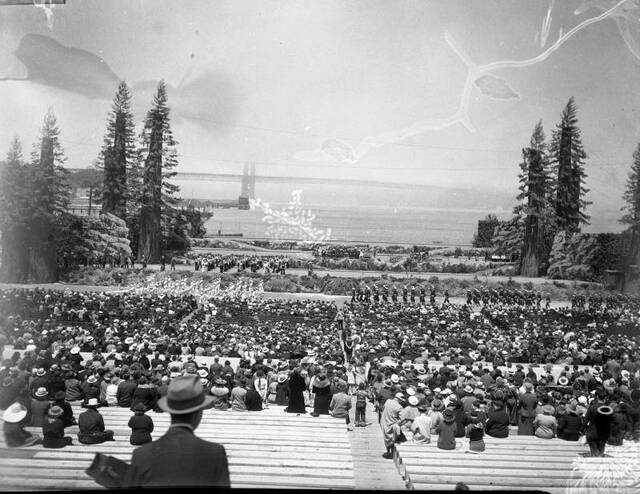
From May 28 to May 30, the festivities surrounding the Golden Gate Bridge’s grand opening escalated into a week-long extravaganza known as the Golden Gate Fiesta. While the bridge itself was the undeniable star, the celebrations turned into a riot of parades, sports events, and over-the-top performances that seemed determined to overshadow the bridge itself.
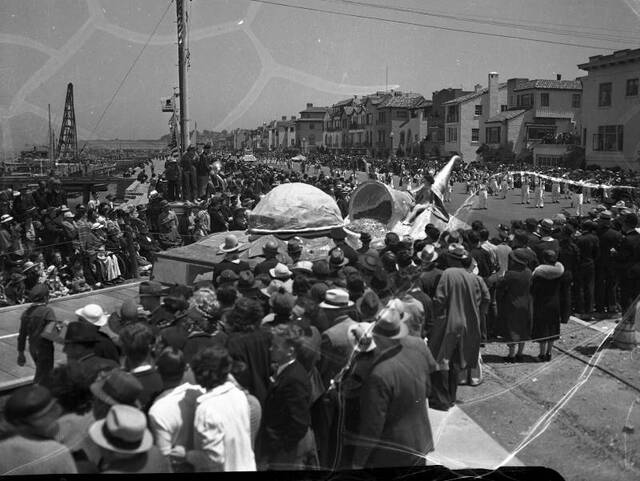
The festivities kicked off with a massive parade down San Francisco’s streets, featuring 3,000 members of the San Francisco School Traffic Patrol, followed by marching bands, soldiers, and dancers. One float, in particular, stood out as particularly bizarre—a bathing suit-clad woman atop a giant diaphragm—which captured the surreal atmosphere of the event. The parade was just the beginning of the chaos, with a whirlwind of activities that seemed to know no boundaries.
For sports enthusiasts, the weekend brought yachting regattas, powerboat races, and baseball tournaments. Those in search of more refined entertainment could attend grand balls, luncheons, and even witness the coronation of multiple queens—much to the confusion of the first bridge queen Vivian Sorenson, who likely never imagined that her role would be contested by so many others.
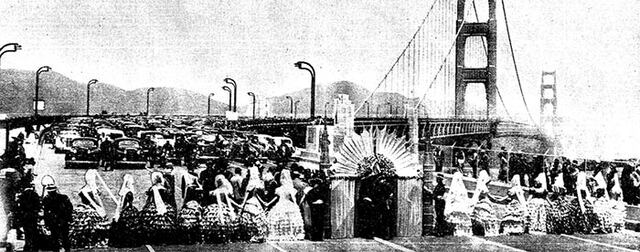
Amidst the madness, one particularly memorable touch was the constant soundtrack of “There’s a Silver Moon on the Golden Gate”—the official song of the entire weekend. Its slow, lilting melody, coupled with some enthusiastic (if slightly off-key) yodeling, added a quirky charm to the festivities. The whimsical nature of the song perfectly captured the chaos and fun that enveloped San Francisco during the Golden Gate Bridge opening celebration. You can get a sense of this unique soundtrack and the spirit of the event by watching the video linked here.
However, no matter how many exciting events there were, the Golden Gate Fiesta became infamous for the traffic that followed. By the time the 8 PM fireworks show rolled around, thousands of cars found themselves caught in what was later dubbed the “worst Marina-Presidio Traffic Jam in History.” The streets were overwhelmed, with cars abandoned, streetcars packed to the brim, and the police helpless in the face of the chaos. It’s safe to say that the Fiesta turned into a memorable, if slightly chaotic, chapter in San Francisco’s history—a fitting backdrop for a bridge that had already become an iconic symbol of both the city and the nation.

A Bridge Connecting People: What the Golden Gate Means Today
Despite the chaos of its opening, the Golden Gate Bridge quickly became an iconic symbol of the United States. The bridge connected San Francisco to Marin County, alleviating traffic woes and allowing for greater access between the two regions. Over the years, the bridge has come to symbolize not just engineering achievement but also the resilience and spirit of the people who made it happen.
Today, the Golden Gate Bridge is among the most visited tourist attractions in the world, drawing millions of visitors each year. The bridge’s opening celebrations, filled with eccentricities, humor, and a little bit of madness, are remembered fondly as a testament to the city’s unique personality and enduring charm.
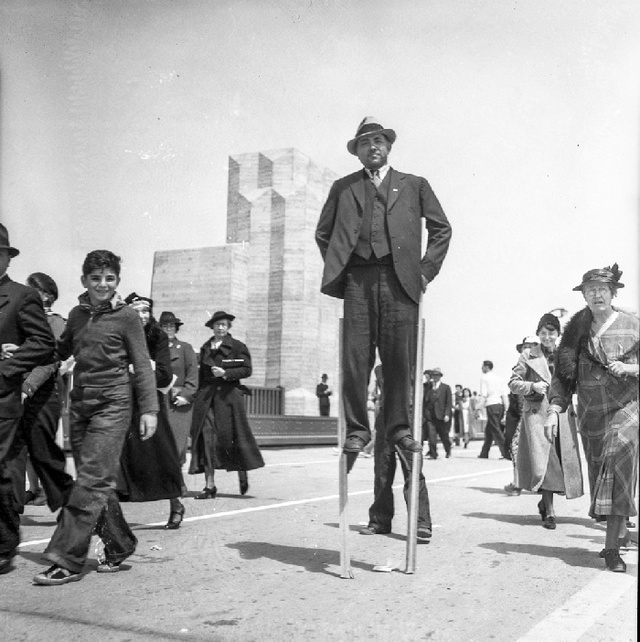
Conclusion: The Golden Gate Bridge – A Legacy of Chaos and Celebration
The opening of the Golden Gate Bridge in 1937 was far from ordinary. It was a chaotic, fun-filled event that reflected the vibrant and eccentric spirit of San Francisco. From the quirky individuals who crossed the bridge on Pedestrian Day to the surreal ceremonies on Clown Car Day and the madness of the Fiesta, the opening marked the beginning of a new chapter in the city’s history. Today, the Golden Gate Bridge stands as a testament to the engineering feat it represents and the lively, celebratory culture of the people who embraced its opening.

